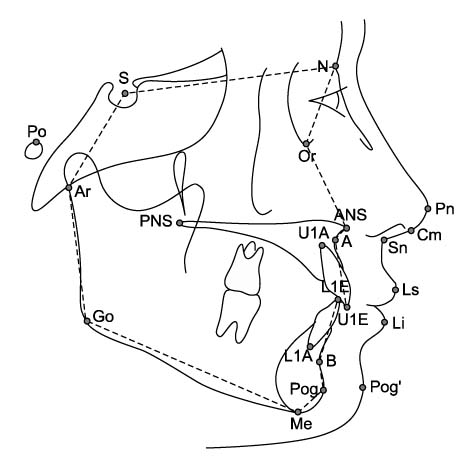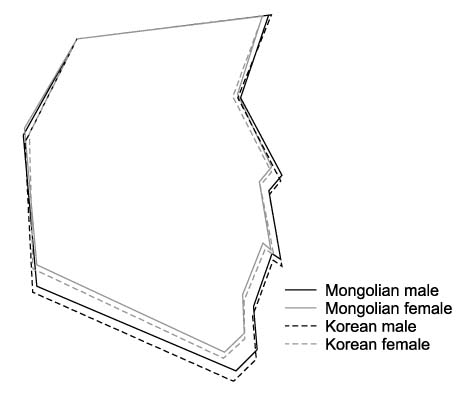Comparison of cephalometric norms between Mongolian and Korean adults with normal occlusions and well-balanced profiles
- Affiliations
-
- 1Department of Prosthodontics and Orthodontics, School of Dentistry, Health Science University of Mongolia, Ulaanbaatar, Mongolia.
- 2Department of Orthodontics, School of Dentistry and Dental Research Institute, Seoul National University, Seoul, Korea. taewoo@snu.ac.kr
- KMID: 1762665
- DOI: http://doi.org/10.4041/kjod.2011.41.1.42
Abstract
OBJECTIVE
The purposes of this study were to establish cephalometric norms of Mongolian adults, which have not previously been reported in orthodontic journals, and to compare them with cephalometric norms of Korean adults.
METHODS
Lateral cephalometric radiographs of 74 Mongolian adults (35 men, 39 women) and 95 Korean adults (52 men, 43 women) with normal occlusions and well-balanced lateral profiles were obtained. The subjects were chosen by orthodontists of the same ethnic background. Forty craniofacial variables were measured, and groups were compared by analysis of covariance.
RESULTS
The cephalometric norms for male and female Mongolian and Korean adults with normal occlusions and well-balanced lateral profiles were established. Sexual dimorphism was found in linear skeletal measurements and vertical skeletal relationships. Compared with Korean adults, Mongolian adults had shorter anterior facial height, more prominent chins, and more upright upper incisors. There were few differences in soft tissue measurements. The differences were statistically significant, but their clinical importance may be limited.
CONCLUSIONS
Cephalometric differences can be considered, but little difference may exist in the orthodontic diagnosis and treatment planning of Mongolian and Korean adults.
Keyword
Figure
Cited by 4 articles
-
Assessment of lower incisor alveolar bone width using cone-beam computed tomography images in skeletal Class III adults of different vertical patterns
Sanghee Lee, Soonshin Hwang, Woowon Jang, Yoon Jeong Choi, Chooryung J Chung, Kyung-Ho Kim
Korean J Orthod. 2018;48(6):349-356. doi: 10.4041/kjod.2018.48.6.349.Pierre Robin sequence with severe scoliosis in an adult: A case report of clinical and radiological features
Jae-Jun Kim, Dong-Soon Choi, Insan Jang, Bong-Kuen Cha, In-Woo Park
Imaging Sci Dent. 2019;49(4):323-329. doi: 10.5624/isd.2019.49.4.323.Differences in mandibular condyle and glenoid fossa morphology in relation to vertical and sagittal skeletal patterns: A cone-beam computed tomography study
Kyoung Jin Noh, Hyoung-Seon Baik, Sang-Sun Han, Woowon Jang, Yoon Jeong Choi
Korean J Orthod. 2021;51(2):126-134. doi: 10.4041/kjod.2021.51.2.126.Comparison of soft tissue changes between incisor tipping and translation after premolar extraction
Wonkyeong Baik, Sung-Hwan Choi, Jung-Yul Cha, Hyung-Seog Yu, Kee-Joon Lee
Korean J Orthod. 2022;52(1):42-52. doi: 10.4041/kjod.2022.52.1.42.
Reference
-
1. Downs WB. Variations in facial relationships; their significance in treatment and prognosis. Am J Orthod. 1948. 34:812–840.
Article2. Steiner CC. Cephalometrics for you and me. Am J Orthod. 1953. 39:729–755.
Article3. Tweed CH. The Frankfort-mandibular incisor angle (FMIA) in orthodontic diagnosis, treatment planning and prognosis. Angle Orthod. 1954. 24:121–169.4. Ricketts RM. Planning treatment on the basis of the facial patterns and an estimate of its growth. Angle Orthod. 1957. 27:14–37.5. el-Batouti A, Ogaard B, Bishara SE. Longitudinal cephalometric standards for Norwegians between the ages of 6 and 18 years. Eur J Orthod. 1994. 16:501–509.
Article6. Cotton WN, Takano WS, Wong WM. The Downs analysis applied to three other ethnic groups. Angle Orthod. 1951. 21:213–220.7. Cooke MS, Wei SH. A comparative study of southern Chinese and British Caucasian cephalometric standards. Angle Orthod. 1989. 59:131–138.8. Wu J, Hägg U, Rabie AB. Chinese norms of McNamara's cephalometric analysis. Angle Orthod. 2007. 77:12–20.
Article9. Miyajima K, McNamara JA Jr, Kimura T, Murata S, Iizuka T. Craniofacial structure of Japanese and European-American adults with normal occlusions and well-balanced faces. Am J Orthod Dentofacial Orthop. 1996. 110:431–438.
Article10. Basciftci FA, Uysal T, Buyukerkmen A. Craniofacial structure of Anatolian Turkish adults with normal occlusions and well-balanced faces. Am J Orthod Dentofacial Orthop. 2004. 125:366–372.
Article11. Huang WJ, Taylor RW, Dasanayake AP. Determining cephalometric norms for Caucasians and African Americans in Birmingham. Angle Orthod. 1998. 68:503–511.12. Hamdan AM, Rock WP. Cephalometric norms in an Arabic population. J Orthod. 2001. 28:297–300.
Article13. Yeong P, Huggare J. Morphology of Singapore chinese. Eur J Orthod. 2004. 26:605–612.
Article14. Yang WS. A roentgenocephalometric study of the linear analyses in normal occlusion for Korean. Korean J Orthod. 1974. 4:7–12.15. Lee KS, Chung KR. A cephalometric analysis of Korean adult normal occlusion. Korean J Orthod. 1987. 17:199–214.16. Park IC, Bowman D, Klapper L. A cephalometric study of Korean adults. Am J Orthod Dentofacial Orthop. 1989. 96:54–59.17. Hwang HS, Kim WS, McNamara JA Jr. Ethnic differences in the soft tissue profile of Korean and European-American adults with normal occlusions and well-balanced faces. Angle Orthod. 2002. 72:72–80.18. Malocclusion Report Publication Committee of KAO. The report of cephalometric measurement study of Korean adults with normal occlusion. 1997. 1–17.19. Georg S, Michalove PA, Ramer AM, Sidwell PJ. Telling general linguists about Altaic. J Linguistics. 1999. 35:65–98.
Article20. Saha N, Tay JS. Origin of the Koreans: a population genetic study. Am J Phys Anthropol. 1992. 88:27–36.
Article21. Chimge NO, Batsuuri J. Interethnic genetic differentiation: HLA class I antigens in the population of Mongolia. Am J Hum Biol. 1999. 11:603–618.
Article22. Kim W, Shin DJ, Harihara S, Kim YJ. Y chromosomal DNA variation in east Asian populations and its potential for inferring the peopling of Korea. J Hum Genet. 2000. 45:76–83.
Article23. Karafet T, Xu L, Du R, Wang W, Feng S, Wells RS, et al. Paternal population history of East Asia: sources, patterns, and microevolutionary processes. Am J Hum Genet. 2001. 69:615–628.
Article24. Jin HJ, Kwak KD, Hammer MF, Nakahori Y, Shinka T, Lee JW, et al. Y-chromosomal DNA haplogroups and their implications for the dual origins of the Koreans. Hum Genet. 2003. 114:27–35.
Article25. Dahlberg G. Statistical methods for medical and biological students. 1940. London: George Allen and Unwin Ltd..26. Casko JS, Shepherd WB. Dental and skeletal variation within the range of normal. Angle Orthod. 1984. 54:5–17.27. Kim JY, Lee SJ, Kim TW, Nahm DS, Chang YI. Classification of the skeletal variation in normal occlusion. Angle Orthod. 2005. 75:311–319.28. Goldstone JA, Gurr TA, Harff B, Levy MA, Marshall MG, Bates RH, et al. State Failure Task Force Report: Phase III Findings. 2000. Accessed June 21, 2010. McLean, VA: Science Applications International Corporation;(Available at: http://globalpolicy.gmu.edu/pitf/).29. Del Santo M Jr. Influence of occlusal plane inclination on ANB and Wits assessments of anteroposterior jaw relationships. Am J Orthod Dentofacial Orthop. 2006. 129:641–648.
Article30. King L, Harris EF, Tolley EA. Heritability of cephalometric and occlusal variables as assessed from siblings with overt malocclusions. Am J Orthod Dentofacial Orthop. 1993. 104:121–131.
Article31. Trenouth MJ, Davies PH, Johnson JS. A statistical comparison of three sets of normative data from which to derive standards for craniofacial measurement. Eur J Orthod. 1985. 7:193–200.
Article32. Alcalde RE, Jinno T, Pogrel MA, Matsumura T. Cephalometric norms in Japanese adults. J Oral Maxillofac Surg. 1998. 56:129–134.
Article33. Pogrel MA. What are normal esthetic values? J Oral Maxillofac Surg. 1991. 49:963–969.
Article34. Ko SJ, Kim HS, Kim YJ. The influence of gender or culture on determining esthetic facial profile. Korean J Orthod. 2001. 31:301–309.
- Full Text Links
- Actions
-
Cited
- CITED
-
- Close
- Share
- Similar articles
-
- Roentgenographic Cephalometric Study for Normal Occlusion in Korean Adults According to the Ricketts Analysis
- A study of vertical harmony of adult craniofacial skelton with normal occlution
- Cephalometric norms of the hard tissues of Korean for orthognathic surgery
- A cephalometric analysis of Korean adult normal occlusion
- Cephalometric norms of the soft tissues of Korean for orthognathic surgery



